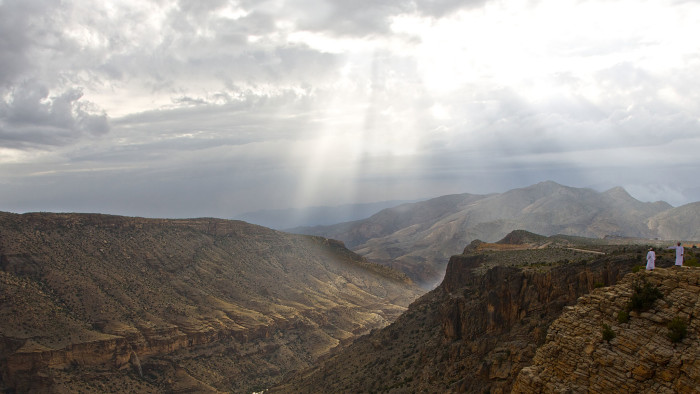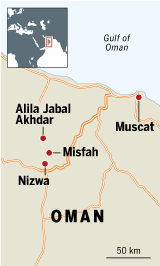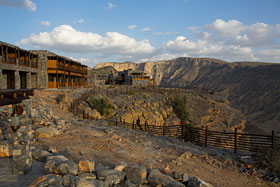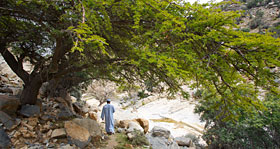Exclusive first look: hotel in dramatic location opens in Oman

Simply sign up to the Life & Arts myFT Digest -- delivered directly to your inbox.
In early 1950, the great desert explorer and writer Wilfred Thesiger set out to climb the Jebel Akhdar, an abrupt wall of mountains and isolated plateaux in the interior of Oman. Thesiger, then 39, was officially an employee of the international Desert Locust Research Organization but the motivating force of his life was, in his words, “to catch the ancient world before it vanished for ever”. Thesiger had spent the past five years travelling, mostly in disguise, seeking silence and decency in Oman’s Empty Quarter, crossing deserts with the Bedouin, finding the quicksands of Umm al Samim. “The harder the life,” he wrote, “the finer the person.”
It was intrigue rather than hardship, though, that drew Thesiger to the Jebel Akhdar. The name translates as the Green Mountain, and for more than a century, European adventurers had come back speaking of mists and sudden valleys, of unreachable villages and pomegranate trees, cooler and fresher than the blinding desert below. James Wellsted, a lieutenant in the East India Company, visited the region in the 1830s and described a lost Persian tribe, an “irascible, slothful, and immoral race” who grew grapes, drank wine and lived lives of mountain fierceness.
A century later, the place had grown all but inaccessible, a mythical redoubt. Thesiger was told that his only chance of getting in was to talk his way round the local ruler, Suleiman bin Hamyar, self-styled “King of Nebhania and Lord of the Green Mountain”. Suleiman was known across Oman, and beyond, as a troublemaker. A big man in a blue and white turban, he kept a castle at the bottom of the Wadi al Hijri, the main route into the Jebel Akhdar, and governed the hilltops with a medieval enthusiasm. He placed his camel stick above the doorways of women he wanted to sleep with, and drove around in an American convertible with a black slave posted on the boot. When Suleiman met Thesiger (who described him as “a powerful if not very congenial personality”), the sheikh told the explorer that he could pass in return for helping him persuade the British government to recognise the Jebel Akhdar as an independent state. Thesiger declined. The way was blocked. Thesiger did not return to Oman for 27 years.

In 1955, Suleiman and a neighbouring sheikh, and his brother, Ghalib, the imam of Oman, began a series of damaging rebellions. By 1959, the British decided they had had enough. Two SAS squadrons, backed by 750 Omani troops, scaled the rebel Jebel Akhdar. The RAF bombed villages and strafed goats around them as they went. Suleiman managed to escape to Saudi Arabia. But the new power in the land did not forget what had happened in the Green Mountain. Sixty-six villages and an area of 122 sq km were sealed off by the army as Oman’s current sultan, Qaboos, who took power in a palace coup in 1970, set about uniting the country for good. The Jebel Akhdar, Thesiger’s goal, did not open again until 2005.
…
I reached the bottom of the mountain at about 10am. A checkpoint still guards the entrance to the Jebel Akhdar, only allowing heavy trucks and 4x4s to climb into the hills above. The road, completed by the military only a few years ago, then snakes hard into the sky. Cliffsides have been gouged and smoothed, as if by some unimaginable carrot peeler, to allow new tarmac to rise almost 3,000m into the hot, endlessly-folding rocks. There are unfeasible paths leading up to water pipes clamped to the barren hillsides but no sign of where they got the whole “green” thing from. It takes a few minutes, a few dozen bends and swoops, before the air begins to thin and cool and the land of the main Saiq plateau, at 2,000m, becomes freckled with uncountable bushes and trees, juniper, wild fig and olive – a million dots of green. But we weren’t stopping there. We climbed again, hundreds of metres higher, and headed towards the edge of the mountain, and the map, where a low line of rocky buildings ran out against the sky.
This was Alila Jabal Akhdar (the owners use an alternative spelling). After decades of exclusion, Oman’s forgotten mountain is now a priority for the country’s developing tourist trade. And Sultan Qaboos, now in the fifth decade of his “era of glory” as ruler, does not mess around. The 86-room, five-star resort, the first of its kind in the interior of Oman, has been built at undisclosed cost by Omran, the country’s tourism investment company. Everything has been trucked up 45km of vertiginous road. Cranes have been disassembled, and reassembled, on the mountaintop. The hotel uses generators otherwise found on submarines, because of their transportable size, and has been rigged to cope with temperatures ranging from freezing in the winter to 35C in the summer.
…
When I arrived, a month ahead of its opening on May 8 and the first journalist to see the hotel, rocks that had been disturbed during three years of construction were in the process of being re-randomised by computer to replicate their natural state before being laid out again by workers in the mountain sun.
It is a staggering piece of building – in the quietest sense. Everything is clad in hand-cut blocks of the intricate grey and pink ophiolite of the Jebel Akhdar mountainscape. The filtration on the greywater sewage system has been turned up to maximum, to stop nutrients leaking out into the fragile mountain ecosystem. Omran has handed over the operation of the hotel to Alila, the boutique hotel chain best known for its design-focused Indonesian resorts. The result is juniper branches painted on the white walls, frankincense burning in the lobby, and a platoon of masseuses, trained in Bali, packing out the enormous spa. All this on a mountain ledge that simply stops: the rooms face air and silence.

The only hard part is believing that it’s real. That goes for the rest of Jebel Akhdar as well. After the best part of half a century as a military zone, the place has a vaguely Potemkin feel. In 2011, it was declared a “scenic reserve” and there are tidy little parks and occasional viewing points for those driving through. The roads are immaculate, drifting occasionally with camouflaged pickups and white 4x4s carrying children to and from their schools in the plain below. There is still a large military base in the Saiq plateau and most people in the Jebel Akhdar are government workers. (When Thesiger finally reached the Green Mountain in 1977, he found it ruined by machines, like the rest of his beloved Arabia).
A few miles away from the Alila, an even bigger development is taking shape: a $53m, 116-room hotel, this time built by Oman’s Ministry of Defence on “Diana’s Point”, another astonishing precipice, which the Princess of Wales visited in 1986.
On the evening I arrived, I headed down a stony track with Salim, the son of a steward at the air base, who would be my guide for the next two days. We came to the abandoned village of Sarab, and stood above a small mountain stream that seemed to run noisily. Frogs rattled purposefully in the twilight. The air was clean and dry. “It’s a kind of treatment,” said Salim. “Sniff the fresh weather itself.”
The next morning he took me to more villages, always stacked against vertical hillsides, or tucked in the lee of some improbable gorge. In Al-Asar we found an old man weighing rose petals and distilling their water in old clay ovens. He gave us coffee, flavoured with cardamom, and fed us dates. In Al-Ain a spring and a lattice of aflaj – irrigation channels invented by the ancient peoples of Oman – fed terraces of rose fields, lined with barley, walnut trees and mishmish (Arabic for apricots). I found a piece of bomb, a relic of the RAF, on the narrow mountain path. Valleys spiralled below us. In Wadi Bani-Habib, Salim led the way through thick groves of pomegranate – the best fruits fetch £3 each in the autumn – to an open-air mosque under cedar trees.

As the rebels knew, having Jebel Akhdar as your base brings the rest of Oman’s interior within reach. The next day we struck out for Nizwa, the old capital and seat of Oman’s imams, and its fort and famous livestock market: middlemen in dishdashas leading goats and calves anticlockwise around a wheel of punters, shouting out bids, examining hooves, with tourists taking pictures on their tablets. At the fine, reconstructed fort, arrows pointed to the “murder holes” – ingenious slots in the walls for pouring boiling dates on unsuspecting intruders. We ate lunch at Misfah, a steep oasis of date palms at the edge of the mountain, and went to see the ruins of Suleiman’s castle at Tanuf. The warlord’s son went on to become Oman’s transport minister but only rubble and a shattered tower remained of the lair of the Lord of the Green Mountain. It was a Friday afternoon, the weekend in Oman. Children were leaping into a bright pool. A goat was being skinned for lunch in the shadow of the trees.
These sights – like the sudden flowerings around hidden springs – are spots of colour in the mountain fastness. The Jebel Akhdar might be green but it is still a forbidding place of rock and cliff, of contours writ, and writ, and writ, across the land. It is also, after a day or two, what you end up staring at: the folds, the arches, the layers, stretched and pressed from giant slabs to the thinnest of pastry. Geologists love the Jebel Akhdar too, for its combination of autochthonous and allochthonous rocks, apparently. The wayward crust, the mélange. For me, I think, it was the mountain’s constancy, in that high light, and then its change: the rapid fade to pink in the setting of the sun, when the night falls like a cold hand on your shoulder.
——————————————-
This article has been amended. The original mistakenly referred to the Princess of Wales being taken to “Diana’s Point” by Dodi Fayed during their relationship in the 1990s. In fact she visited long before that, in 1986.
——————————————-
Sam Knight was a guest of Scott Dunn, which offers four nights at Alila Jabal Akhdar from £1,090, including private airport transfers. Return flights from London with Oman Air add about £500
Comments